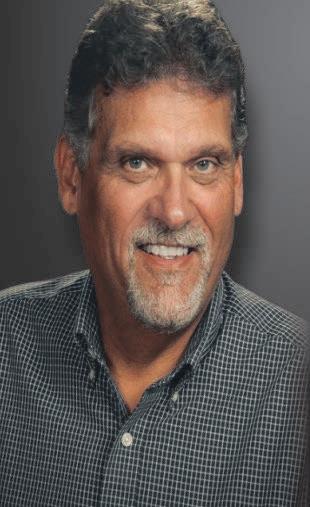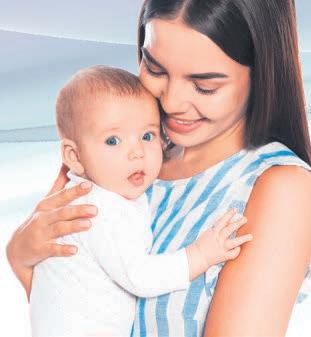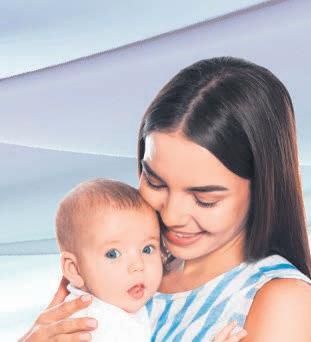
5 minute read
HEALTH
BY SARAH HUBER FOR MYWINDSOR
MARCH 1
IS NATIONAL BABY SLEEP DAY Baby Sleep Day, marked on March 1 by the Pediatric Sleep Council, might be every parent’s favorite holiday – if they can get their baby to participate.
After all, sleeping through the night isn’t only a new parent’s REM-dream come true, it’s vital to infant health.During sleep, infant brains form neural connections – millions per second, so each moment of sleep really counts – and recharge for a new day of learning. Physical growth and immune system development are closely connected with sleep, and babies whoreceive adequate sleep are calmer and more responsive when awake, according to the Pediatric Sleep Council.
Yet,what’s a caregiver with a wide-eyed baby to do?Two local experts, a specialist with Pediatric Sleep Specialists’ northern Colorado clinics and an award-winning Loveland pediatrician, offered the following tips to exhausted parents.
Tried-And-True Routines
Routine is the bedrock of healthy baby sleep, according to Dr. Mike Quintana,pediatrician at LovelandYouth Clinic.For newborns, guidelines from the AmericanAcademy ofPediatrics (AAP) recommend 20 hours of daily sleep, divided into night sleep and two to three naps.Sleep requirements drop aschildren age, with babies four to six months sleeping 16 to 20 hours over 24 hours.“Around six to eight months, kids wake up,”said Quintana.“They eat, play, interact, drop off to nap.”By age one, pediatric guidelines recommend 12 to 16 hours of sleep a day, including naps.
Jessica Ballou of Pediatric Sleep Specialists noted, “Healthy babies do not require nighttime feeds after three months of age. They areable to learn to self-soothe as earlyas three months and definitely by six months of age.This is also when their circadian rhythm starts to develop. The effect of these changes is that they transition to sleeping more at night than during the day.”
Quintana acknowledged sleep transitions, from dropping a nighttime feeding to sleeping for longer spans, may be difficult for caregivers, who learn “on the job” about when and how to respond to a baby’s cry. Referencing the French model,in which parents expect babies to sleep in five-hour nighttime segments by three months,he said parents“should check on a baby crying in the night and if there is no medical condition, like a fever or a foot stuck in the side of the crib, they should touch and look at the baby,then say‘good night, baby’and head back out of the room.”
WhenToSeekHelpFor Baby Sleep
Of course, not only does this type of sleep training take mammoth will-power for many caregivers, it may not be a good fit for some parents, Ballou said. At that point, it can be useful to reach out to a baby’s pediatrician or a sleep specialist for an assessment and to rule out any physical health concerns. Likewise, caregivers should seek support if a child experiences difficultyfallingorstayingasleep,snoring,gasping,restlesssleep, sleep terrors, sleep talking or sleepwalking, difficulty waking in the morning or daytime sleepiness, Ballou said. Both Quintana and Ballou said dabbling in the myriad of “baby sleep cures” offered online is rarely helpful.
As with adults, the most commonly diagnosed sleep problem with babies is insomnia, or difficulty falling and staying asleep.
Ballou often employs cognitive behavioral therapy for insomnia and modified extinctions therapies to treat infant insomnia and sleep onset associations. These associations, such as a parent’s presence, a beloved object or a rocking motion, can make it difficult for babies to fall asleep independently and can cause prolonged night awakenings.
For babies who are sleeping well but then experience sleep regression,returning toa schedule is essential.Stick to consistent bedtimes and wake times, Ballou said, and put baby down to sleep while awake. “This allows for babies to learn to self-soothe and tobeable to fall asleep and stay asleep on theirown,”she said.
Safe sleep
Healthy sleep demands safe sleep.To prevent SIDS, orSudden Infant Death Syndrome, babies should always be placed on their backduringsleeponafirmsurfacewithoutloosesheets,bumpers or stuffed animals, said Quintana and Ballou. While it may be convenient for parents to keep the baby in a bassinette in their room for the first six months, AAP guidelines recommend never co-sleeping, whether in bed or on a couch. Ballou continued, “Swaddlinga baby is appropriate, but once they areable toroll, do not swaddle your baby and make sure their arms are out if using a sleep sack.”
Finally, helping baby sleep well affects the health of everyone in the home. Ballou said, “When babies are sleeping better, the whole family canbenefitbyallowing more sleep opportunitiesfor everyone.”She added,“Parents should not haveto tackletreating sleep problems alone.”
ROB KNOWS REAL ESTATE
With 18 years experience in the real estate industry, I have experience in every aspect of this business. If you’re thinking of buying, selling or building, contact me. Let’s work together to position your property for a speedy sale at top dollar or find your next dream home.

R ROB PROCTOR


Broker/Owner, Br GRI, e-PRO, Realtor G At Home Real Estate Company At
970) 481-2133 (970) 481-2133


For some, an infant check by a pediatric certified chiropractor can stave off sleep issues or resolve the source of sleep struggles after a few adjustments. Dr. Patricia Sorbo, who owns Weld Family Clinic of Chiropractic with her husband, Dr. Erik Sorbo, explained, “The birth process can be traumatic, not only for the mother, but for the infant as well. Checking the newborn ’ s spine for vertebral subluxations as soon as possible can resolve these issues before they become problems. ” Crucially, babies are not simply small-sized adults, as Sorbo stated, so she urged parents to consider only chiropractors who are certified in pediatric chiropractic care and who use very light pressure. One of Sorbo ’ s clients, a mom with a sleep-averse baby, said chiropractic care was a lifeline for her family. She wrote, “Before meeting Dr. Patricia, I was exhausted, terrified and overwhelmed with a colicky baby. Sleep deprivation was making me insane. She cried non-stop and never seemed to get comfortable. ” While the mom admitted she was “ nervous to let someone adjust my baby, ” she said, “Dr. Patricia put my mind at ease and showed that she has extensive training and experience working on kids and babies. ”








